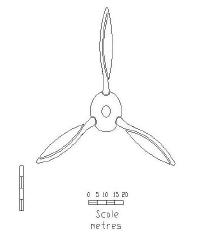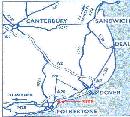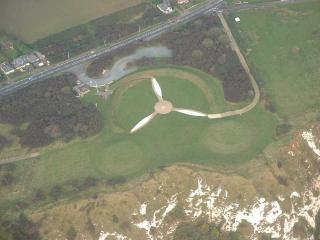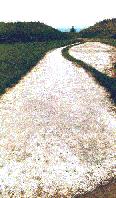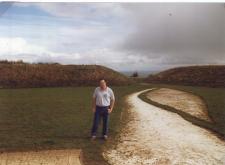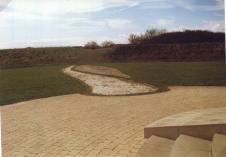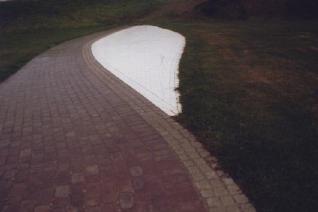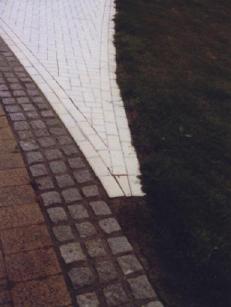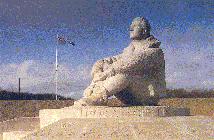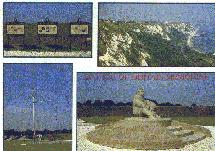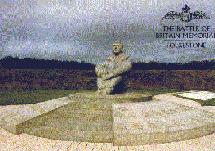Battle of Britain Memorial
In Conjunction with the Battle of Britain Memorial Trust
National Grid Ref TR 245 381
General Information
The Battle of Britain Memorial which is in the shape of a Propeller is situated on the Cliffs just outside Capel-le-Ferne just off the B2011 about 2 miles from Folkestone and it is signposted from the A20.
There is a car park (no charge) several information boards, and a souvenir shop that sells tea and coffee. There are benches and the view from the cliff top is impressive, and the coast of northern France can be seen on a clear day.
The Memorial is only open between 1st of April and 11th of November. Further opening information can be obtained from the site itself on (01303) 249 292.
The memorial is looked after by the Battle of Britain Memorial Trust, donations for its continued upkeep are welcome, payable to the Battle of Britain Memorial Trust. These are to be sent along with any request for further information to
Battle of Britain Memorial Trust
c/o County HQ
RBL Village
Aylesford
Kent
ME20 7NY
Charity Commission Number 803258
A memorial day is held on the Sunday closest to July 10th each year, which will be Sunday 11th July in 1999 and Sunday 9th July in 2000. The millennium memorial day is also the 60th Anniversary of the Battle of Britain, and there will be a large display of aircraft, flybys and other attractions. Entrance to these memorial days is free, and well worth a visit.
History
The Battle of Britain Memorial like the Lenham and Shoreham memorials it is a war memorial, remembering those who lost their lives in the battle. The Battle of Britain Memorial as its name sounds is devoted to the memory of those lost in the Battle of Britain from July to September 1940. It was the idea of Wing Commander Geoffrey Page DSO DFC, himself a veteran of the Battle, that there should be a permanent, national memorial. The Cliff tops of Kent over which most of the Battle was fought was an appropriate location.
It was opened by Her Majesty the Queen on 9th July 1993, and was constructed between November 1992 and July 1993. It is recessed in the cliff top slightly, with banked up edges which can be used for viewing, although reasonable views can be had from this vantage point the best view is from the air and it was designed as such. The memorial is in the form of a three bladed propeller.
The three blades are chalk, cut into the cliff top with a central stone memorial and stone paved area. The central stone memorial is of Bickstead Blue Stone, and the rest of the stone memorial is of Sandstone.
This construction was modified in July 2000, with the chalk blades being replaced with white bricks. The figure is approx. 60 metres wide, the blades are 3.5 metres wide at their widest point.
The design of the centre piece of the memorial was that of Harry Gray of The Carving Workshop, Cambridge. It was chosen from a shortlist of three designs by the trustees, its more modern approach of a lone pilot in contemplative mood was felt to be more appropriate to the memory of those who lost their lives in the Battle. Beneath the figure are the Squadron Crests of those squadrons who flew in the Battle of Britain, many no longer in existence. The site also has the flagpole from Biggin Hill R.A.F. base (which played a major part in the air defence of Britain), which was kindly donated by Savas Constantinides.
The Battle of Britain Memorial is one of many places to visit in Kent, in addition to the other hill figures, the south coast of Kent has many places of historic importance and particularly the history of the Battle of Britain and WWII, contact the tourist board for further information.
The Battle of Britain
The R.A.F. was decimated during the defence of France and was ill prepared for the defence of an invasion, and in July of 1940, Hitler grew tired of waiting for Britain's surrender and made plans for the invasion of Britain. German forces of 60,000 men were to be landed along the coast between Folkestone and Brighton. He aimed to capture the whole of Kent by October 1940, having commenced the invasion on 21st September.
The battle for air superiority over the Channel began on 10th July. By August having suffered many casualties the Luftwaffe shifted emphasis and concentrated on mainland radar installations, airfields and aircraft factories. When they realised that their aim to achieve air superiority over South East England in four days had not been successful, the emphasis was again switched.
On 15th September, the Battle reached its climax when 20 squadrons engaged the German bombers and fighters, downing 60 aircraft and damaging 25; the R.A.F. lost 26. The battered Luftwaffe accepted defeat by the R.A.F. Fighter Command and this victory marked a turning point in the Second World War.
Diagram
Map
Photo's
The Memorial From the Air, Courtesy Vic Seymour.
Many Thanks to Jean-Marie, Pierre-Henry and Christophe Mathy for the photo.
Views from the Ground before conversion to Brick
Views from the Ground after conversion to Brick
Postcards Available from the Lodge
Produced with the aid and approval of the Battle of Britain Memorial Trust
